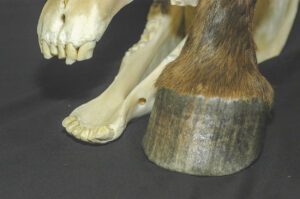Study Investigates How Long Bisphosphonates Stay in Horse Bones
- Topics: AAEP Convention, AAEP Convention 2020, Horse Care, Lameness, Medications

A team from the University of California, Davis, (UC Davis) and the University of Kentucky recently took the first step toward describing bisphosphonates’ residence time in horses’ bones. Heather K. Knych, DVM, PhD, Dipl. ACVCP, professor of Clinical Veterinary Pharmacology at UC Davis’ K.L. Maddy Equine Analytical Pharmacology Lab, presented their findings at the 2020 American Association of Equine Practitioners’ convention, held virtually.
How Do Bisphosphonates Work?
Knych first described what we do know about bisphosphonates and their mechanism of action. Under normal circumstances, the processes of bone formation and bone resorption are in balance. However, she explained, in some circumstances, such as aging, this balance can become disrupted, and resorption can overwhelm formation. The result is weakening of the bone.
Doctors use bisphosphonates to increase bone density and treat disorders of bone resorption (e.g., osteoporosis, Paget’s disease) in humans. In horses, these drugs (tiludronate, clodronate) are labeled to treat the clinical signs associated with navicular disease; however, veterinarians also administer them off-label for other bone disorders
Create a free account with TheHorse.com to view this content.
TheHorse.com is home to thousands of free articles about horse health care. In order to access some of our exclusive free content, you must be signed into TheHorse.com.
Start your free account today!
Already have an account?
and continue reading.

Related Articles
Stay on top of the most recent Horse Health news with

















